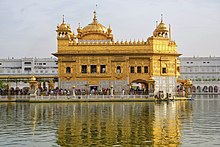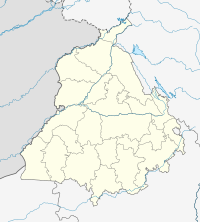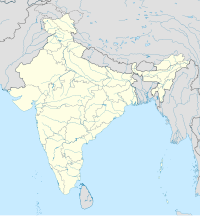
Back المعبد الذهبي Arabic هارمندير صاحب ARZ অমৃতসৰৰ স্বৰ্ণমন্দিৰ Assamese Templu Doráu AST Qızıl məbəd (Hindistan) Azerbaijani Һармандир-Сәһиб Bashkir Auksėnė švėntuobė BAT-SMG Златен храм Bulgarian হরমন্দির সাহিব Bengali/Bangla Harmandir Sahib Catalan
| Golden Temple | |
|---|---|
Harmandir Sahib Darbar Sahib | |
 | |
| Religion | |
| Affiliation | Sikhism |
| Location | |
| Location | Amritsar |
| State | Punjab |
| Country | India |
| Geographic coordinates | 31°37′12″N 74°52′35″E / 31.62000°N 74.87639°E |
| Architecture | |
| Founder | Guru Arjan |
| Groundbreaking | December 1581[1] |
| Completed | 1589 (temple), 1604 (with Adi Granth) [1] |
| Website | |
| sgpc | |
The Golden Temple (also known as the Harmandir Sahib (lit. 'House of God', Punjabi pronunciation: [ɦəɾᵊmən̪d̪əɾᵊ saːɦ(ɪ)bᵊ]), or the Darbār Sahib, (lit. ''exalted court'', [d̪əɾᵊbaːɾᵊ saːɦ(ɪ)bᵊ] or Suvaran Mandir[2]) is a gurdwara located in the city of Amritsar, Punjab, India.[3][4] It is the pre-eminent spiritual site of Sikhism. It is one of the holiest sites in Sikhism, alongside the Gurdwara Darbar Sahib Kartarpur in Kartarpur, and Gurdwara Janam Asthan in Nankana Sahib.[3][5]
The man-made pool on the site of the temple was completed by the fourth Sikh Guru, Guru Ram Das, in 1577.[6][7] In 1604, Guru Arjan, the fifth Sikh Guru, placed a copy of the Adi Granth in the Golden Temple and was a prominent figure in its development.[3][8] The gurdwara was repeatedly rebuilt by the Sikhs after it became a target of persecution and was destroyed several times by the Mughal and invading Afghan armies.[3][5][9] Maharaja Ranjit Singh, after founding the Sikh Empire, rebuilt it in marble and copper in 1809, and overlaid the sanctum with gold leaf in 1830. This has led to the name the Golden Temple.[10][11][12]
The Golden Temple is spiritually the most significant shrine in Sikhism. It became a centre of the Singh Sabha Movement between 1883 and the 1920s, and the Punjabi Suba movement between 1947 and 1966. In the early 1980s, the gurdwara became a centre of conflict between the Indian government and a radical movement led by Jarnail Singh Bhindranwale.[13] In 1984, Prime Minister Indira Gandhi sent in the Indian Army as part of Operation Blue Star, leading to the deaths of thousands of soldiers, militants and civilians, as well as causing significant damage to the gurdwara and the destruction of the nearby Akal Takht. The gurdwara complex was rebuilt again after the 1984 attack on it.[5]
The Golden Temple is an open house of worship for all people, from all walks of life and faiths.[3] It has a square plan with four entrances, and a circumambulation path around the pool. The four entrances to the gurudwara symbolises the Sikh belief in equality and the Sikh view that all people are welcome into their holy place.[14] The complex is a collection of buildings around the sanctum and the pool.[3] One of these is Akal Takht, the chief centre of religious authority of Sikhism.[5] Additional buildings include a clock tower, the offices of the Gurdwara Committee, a Museum and a langar – a free Sikh community-run kitchen that offers a vegetarian meal to all visitors without discrimination.[5] Over 150,000 people visit the holy shrine everyday for worship.[15] The gurdwara complex has been nominated as a UNESCO World Heritage Site, and its application is pending on the tentative list of UNESCO.[16]
- ^ a b Arvind-Pal Singh Mandair 2013, pp. 41–42.
- ^ McLeod, W.H. (2014). Historical Dictionary of Sikhism. Rowman & Littlefield Publishers. p. 146. ISBN 978-1442236011. Archived from the original on 8 April 2023. Retrieved 19 March 2023.
The latter name was attached to it after Maharaja Ranjit Singh gilded the upper two stories, and it became known as the Suvaran Mandir, or the Golden Temple
- ^ a b c d e f Kerr, Ian J. (2011). "Harimandar". In Harbans Singh (ed.). Encyclopaedia of Sikhism. Punjabi University Patiala. pp. 239–248. Retrieved 1 July 2018.
- ^ Eleanor Nesbitt 2016, pp. 64–65, 150.
- ^ a b c d e "Harmandir-Sahib". Encyclopedia Britannica. 2014. Archived from the original on 10 March 2018. Retrieved 2 May 2018.
- ^ Louis E. Fenech & W. H. McLeod 2014, p. 33.
- ^ Pardeep Singh Arshi 1989, pp. 5–7.
- ^ W. Owen Cole 2004, p. 7
- ^ Cite error: The named reference
runion70was invoked but never defined (see the help page). - ^ Trudy Ring, Noelle Watson & Paul Schellinger 2012, pp. 28–29.
- ^ Eleanor Nesbitt 2016, pp. 64–65.
- ^ Jean Marie Lafont (2002). Maharaja Ranjit Singh: Lord of the Five Rivers. Oxford University Press. pp. 95–96. ISBN 978-0-19-566111-8.
- ^ Fenech, Louis E. (2014). The Oxford Handbook of Sikh Studies. OUP Oxford. pp. 30–31. ISBN 978-0-19-969930-8. Archived from the original on 8 April 2023. Retrieved 19 March 2023.
But this strategy backfired in the spring of 1984, when a group of armed radicals led by Bhindranwale decided to provoke a confrontation with the government by occupying Akal Takhat building inside the Golden Temple complex.
- ^ "Nature and importance of Harmandir Sahib – Pilgrimage". BBC (GCSE Religious Studies Revision ed.). Archived from the original on 16 March 2022. Retrieved 17 March 2022.
- ^ "Soon, Golden Temple to use phone jammers". The Times of India. 19 July 2012. Archived from the original on 26 January 2013. Retrieved 25 May 2023.
- ^ Sri Harimandir Sahib, Amritsar, Punjab Archived 16 May 2022 at the Wayback Machine, UNESCO


